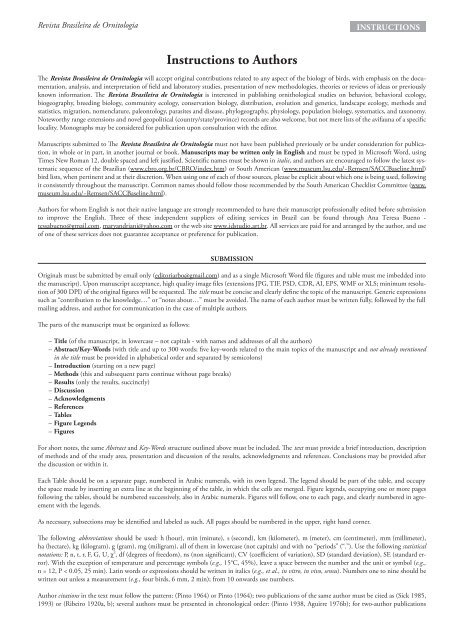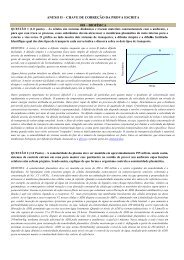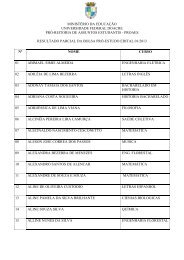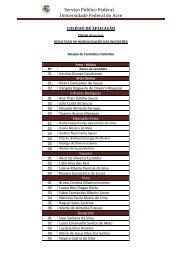Revista Brasileira de Ornitologia - Universidade Federal do Acre
Revista Brasileira de Ornitologia - Universidade Federal do Acre
Revista Brasileira de Ornitologia - Universidade Federal do Acre
You also want an ePaper? Increase the reach of your titles
YUMPU automatically turns print PDFs into web optimized ePapers that Google loves.
<strong>Revista</strong> <strong>Brasileira</strong> <strong>de</strong> <strong>Ornitologia</strong>INSTRUCTIONSInstructions to AuthorsThe <strong>Revista</strong> <strong>Brasileira</strong> <strong>de</strong> <strong>Ornitologia</strong> will accept original contributions related to any aspect of the biology of birds, with emphasis on the <strong>do</strong>cumentation,analysis, and interpretation of field and laboratory studies, presentation of new metho<strong>do</strong>logies, theories or reviews of i<strong>de</strong>as or previouslyknown information. The <strong>Revista</strong> <strong>Brasileira</strong> <strong>de</strong> <strong>Ornitologia</strong> is interested in publishing ornithological studies on behavior, behavioral ecology,biogeography, breeding biology, community ecology, conservation biology, distribution, evolution and genetics, landscape ecology, methods andstatistics, migration, nomenclature, paleontology, parasites and disease, phylogeography, physiology, population biology, systematics, and taxonomy.Noteworthy range extensions and novel geopolitical (country/state/province) records are also welcome, but not mere lists of the avifauna of a specificlocality. Monographs may be consi<strong>de</strong>red for publication upon consultation with the editor.Manuscripts submitted to The <strong>Revista</strong> <strong>Brasileira</strong> <strong>de</strong> <strong>Ornitologia</strong> must not have been published previously or be un<strong>de</strong>r consi<strong>de</strong>ration for publication,in whole or in part, in another journal or book. Manuscripts may be written only in English and must be typed in Microsoft Word, usingTimes New Roman 12, <strong>do</strong>uble spaced and left justified. Scientific names must be shown in italic, and authors are encouraged to follow the latest systematicsequence of the Brazilian (www.cbro.org.br/CBRO/in<strong>de</strong>x.htm) or South American (www.museum.lsu.edu/~Remsen/SACCBaseline.html)bird lists, when pertinent and at their discretion. When using one of each of those sources, please be explicit about which one is being used, followingit consistently throughout the manuscript. Common names should follow those recommen<strong>de</strong>d by the South American Checklist Committee (www.museum.lsu.edu/~Remsen/SACCBaseline.html).Authors for whom English is not their native language are strongly recommen<strong>de</strong>d to have their manuscript professionally edited before submissionto improve the English. Three of these in<strong>de</strong>pen<strong>de</strong>nt suppliers of editing services in Brazil can be found through Ana Teresa Bueno -tessabueno@gmail.com, maryandriani@yahoo.com or the web site www.idstudio.art.br. All services are paid for and arranged by the author, and useof one of these services <strong>do</strong>es not guarantee acceptance or preference for publication.SUBMISSIONOriginals must be submitted by email only (editoriarbo@gmail.com) and as a single Microsoft Word file (figures and table must me imbed<strong>de</strong>d intothe manuscript). Upon manuscript acceptance, high quality image files (extensions JPG, TIF, PSD, CDR, AI, EPS, WMF or XLS; minimum resolutionof 300 DPI) of the original figures will be requested. The title must be concise and clearly <strong>de</strong>fine the topic of the manuscript. Generic expressionssuch as “contribution to the knowledge…” or “notes about…” must be avoi<strong>de</strong>d. The name of each author must be written fully, followed by the fullmailing address, and author for communication in the case of multiple authors.The parts of the manuscript must be organized as follows:– Title (of the manuscript, in lowercase – not capitals - with names and addresses of all the authors)– Abstract/Key-Words (with title and up to 300 words; five key-words related to the main topics of the manuscript and not already mentionedin the title must be provi<strong>de</strong>d in alphabetical or<strong>de</strong>r and separated by semicolons)– Introduction (starting on a new page)– Methods (this and subsequent parts continue without page breaks)– Results (only the results, succinctly)– Discussion– Acknowledgments– References– Tables– Figure Legends– FiguresFor short notes, the same Abstract and Key-Words structure outlined above must be inclu<strong>de</strong>d. The text must provi<strong>de</strong> a brief introduction, <strong>de</strong>scriptionof methods and of the study area, presentation and discussion of the results, acknowledgments and references. Conclusions may be provi<strong>de</strong>d afterthe discussion or within it.Each Table should be on a separate page, numbered in Arabic numerals, with its own legend. The legend should be part of the table, and occupythe space ma<strong>de</strong> by inserting an extra line at the beginning of the table, in which the cells are merged. Figure legends, occupying one or more pagesfollowing the tables, should be numbered successively, also in Arabic numerals. Figures will follow, one to each page, and clearly numbered in agreementwith the legends.As necessary, subsections may be i<strong>de</strong>ntified and labeled as such. All pages should be numbered in the upper, right hand corner.The following abbreviations should be used: h (hour), min (minute), s (second), km (kilometer), m (meter), cm (centimeter), mm (millimeter),ha (hectare), kg (kilogram), g (gram), mg (miligram), all of them in lowercase (not capitals) and with no “periods” (“.”). Use the following statisticalnotations: P, n, t, r, F, G, U, χ 2 , df (<strong>de</strong>grees of free<strong>do</strong>m), ns (non significant), CV (coefficient of variation), SD (standard <strong>de</strong>viation), SE (standard error).With the exception of temperature and percentage symbols (e.g., 15°C, 45%), leave a space between the number and the unit or symbol (e.g.,n = 12, P < 0.05, 25 min). Latin words or expressions should be written in italics (e.g., et al., in vitro, in vivo, sensu). Numbers one to nine should bewritten out unless a measurement (e.g., four birds, 6 mm, 2 min); from 10 onwards use numbers.Author citations in the text must follow the pattern: (Pinto 1964) or Pinto (1964); two publications of the same author must be cited as (Sick 1985,1993) or (Ribeiro 1920a, b); several authors must be presented in chronological or<strong>de</strong>r: (Pinto 1938, Aguirre 1976b); for two-author publications










